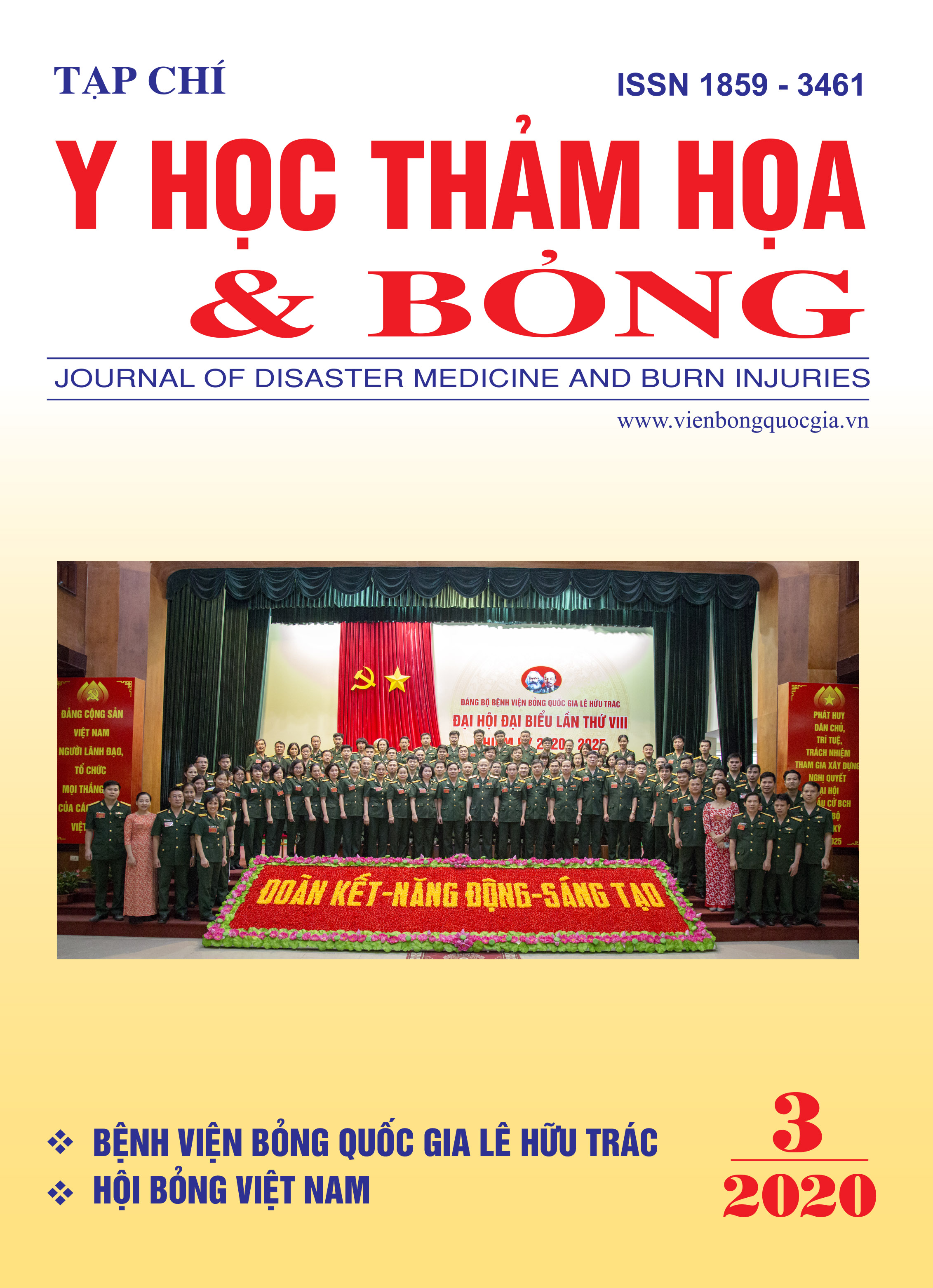Evaluate the locally therapeutic effect of 2.2% Ceri nitrate gel on burn wound
Main Article Content
Abstract
Introduction: Deep epidermal burns (intermediate burns) is often complicated by necrosis causing severe inflammation and infection. Cerium Nitrate is an effective spot treatment remedy that has an antibacterial, anti-inflammatory, and drying effect on wet necrosis. In 2019, the National Hospital of Burns produced 2.2% Cerium nitrate gel (up to baseline standard).
Aims: This study aimed to evaluate the effectiveness and safety of the gel at deep dermis burns.
Subjects: Patients with deep III-degree burns, treated at the Le Huc Trac National Burn Hospital; compare the therapeutic effect of clinical Cerium nitrate gel with 1% SSD cream.
Result: The results showed that in the experimented area, the necrosis was dry, inflammation, and pus discharge was significantly reduced compared to that of the control. The duration of treatment is significantly shortened. There were no systemic and local side effects.
Conclusion: Cerium nitrate gel is safe for use, effectively drying necrosis, and its anti-inflammatory, and facilitate healing tremendously.
Article Details
Keywords
Cerium nitrate, deep dermis burn, 1% SSD cream, necrosis
References
2. Heruzo C.R, Garcia T.V, Rey-Calero J, Vizcaino M.J (1992).Evaluation of the penetration strength, bactericidal efficacy and spectrum of action of several antibacterial creams against microorganisms in a burn centre. Burns 18:39-44.
3. Peterson V.M, Hansbrough J.F, Wang X.W, Boswick J.A (1985). Topical cerium nitrate prevents postburn immunosuppression. J Trauma 25(11):1039-44.
4. Deveci M, Eski M, Sengezer M, Kisa U (2000).Effects of cerium nitrate bathing and prompt burn wound excision on IL-6 and TNF-α levels in burned rats. Burns, Volume 26, Issue 1, Pages 41-45, February
5. Sengezer M, Deved M, Eski M. (1998).Cerium nitrate bathing prevents TNF-α elevation following burn injury (experimental study). Ann Medit Burns Club.;11(4):227-231
6. Eski M, Firat Ozer, Cemal Firat, Doğan Alhan, Nuri Arslan, Tolga Senturk (2012).Cerium nitrate treatment prevents progressive tissue necrosis in the zone of stasis following burn, Burns, Volume 38, Issue 2, Pages 283-289, March.
7. David N. Herndon (2018). total burn care, Elsevier, fifth edition
8. Lê Thế Trung (2003). Bỏng- những kiến thức chuyên ngành”- NXB bản y học
9. Mathias Haefeli, Achun Elfering (2005). Pain assessment; Eur. Spine, 2006, Jan., 15(suppl 1): S17-S24.
10. Halkes SBA, et al. (2001). The use tannic acid in the local treatment of burn wounds: intriguing old and new perspectives. Wounds. 2001; 13(4):144-158
11. Nguyễn Ngọc Tuấn (2015). Nghiên cứu bào chế dung dịch Ceri nitrat và gel Ceri nitrat, bước đầu đánh giá tác dụng điều trị của chế phẩm tại vết thương bỏng; đề tài nghiên cứu cấp sở Khoa học và Công nghệ Hà Nội
12. Boeckx W, Blondeel P.N, Vandersteen K et al. (1992). “Effect of cerium nitrate-silver sulphadiazine on deep dermal burns: a histological hypothesis”. Burns 18(6):456-62.
13. Gruner S, Diezel W, Strunk D, Eckert R, Siems W, Anhalt GJ (1991),“Inhibition of Langerhans cell ATPase and contact sensitization by lanthanides-role of T suppressor cells”.J Invest Dermatol.; 97:478-482
14. Gruner S, Sehrt I, Muller GM, Zwirner A, Strunk D, Sonnichsen N (1992), “Inhibition of histamine release from human granulocytes by ions of rare earth elements lanthanum and cerium”. Agents Actions. ;36:207-211
15. Robert Cartotto (2017);Topical antimicrobial agents for pediatric burns, Burns & Trauma2017, 5:33
16. Julian Vitse, Huidi Tchero, Sylvie Meaume (2018). Silver Sulfadiazine and Cerium Nitrate in Ischemic Skin Necrosis of the Leg and Foot: Results of a Prospective Randomized Controlled Study; the international journal of lower extremity wounds; https://journals.sagepub.com/home/ijl
17. Evans CH.Interesting and useful biochemical properties of lanthanides. Trends Biochem Sci. 1983; 445-449


